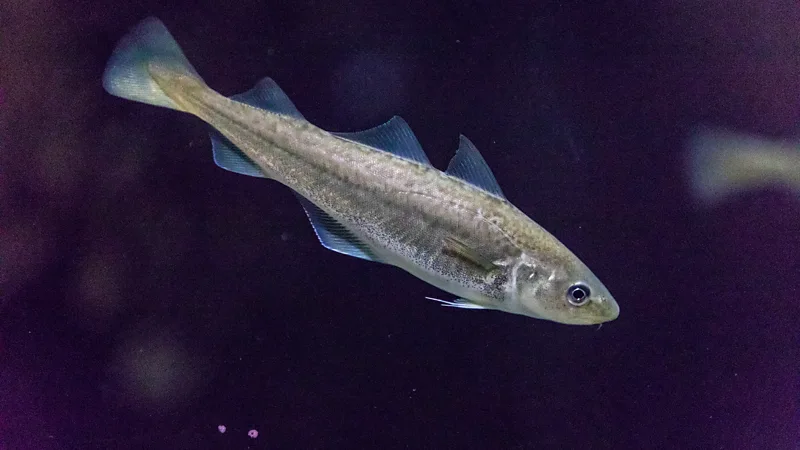Boops, hums and farts: The mysterious world of fish communication
From mysterious clicking noises in a fish tank in a lab, to humming haddocks and singing toadfish, scientists are discovering the wonder of underwater communication.

When you think about how fish communicate with each other, it might conjure little more than a watery silence, punctuated by the odd bubble.
In reality, however, "the oceans are alive with sound", says Aaron Rice, a researcher at Cornell University in Ithaca in New York. Clicks, grunts, plops and screeches are just some of the sounds fish use to signal to those around them underwater. Some, such as toadfish, sing beautiful songs to each other, and others, such as herring, communicate using their digestive tracts – more on this later. They use these signals for a variety of reasons: to warn off competitors, sound the alarm and even to woo potential mates.
Clues that fish are chattier than we might have given them credit for have floated around since the 4th Century, from the works of Aristotle to whispers from traditional fishing communities, says Rice. But our ability to eavesdrop on fish has been limited by the devices used to record underwater. (Read more about why scientists are eavesdropping on the ocean in this article by Katherine Latham.)
Acoustic monitoring has come a long way since the 1930s, and scientists are now using underwater microphones, called hydrophones, to listen in on the marine world. Technology invented in World War Two to scout for submarines has helped us listen to the ways fish talk to one another in the depths of oceans, rivers and lakes.
One tiny fish appears to use a deafening sound to establish a hierarchy in the fish tank
Out of the estimated 34,000-35,000 ray-finned fish species alone, which include cod, tuna, trout and salmon, only around 4% have been studied for their sound production. But Rice's research suggests we have only scratched the surface of the mysterious world of fish communication. Up to two-thirds of fish could be making noises underwater, he says.
In February 2024, researchers in Germany discovered one tiny transparent fish called Danionella cerebrum, which produces a sound so loud it could rival a pneumatic drill. They discovered it after hearing mysterious clicking noises coming from the fish tanks in their laboratory. The 12mm- (0.5in) long fish uses an organ called a swim bladder to produce sounds as loud as 140 decibels in the water around it. The researchers aren't clear what purpose this noise has, but only male fish appear to make the sound and it may be used to establish a sort of hierarchy in the fish tanks. (Read more about Danionella cerebrum and its deafening calls in this story by the BBC's environment correspondent Matt McGrath.)
Fish tend to pipe up for reproductive and territorial reasons. Or, more simply, for food and sex, says Rice. Underwater noises sound a lot clearer to fish than they do to us.
"Sound underwater travels about five times faster than it does in air," says Audrey Looby, an ecologist at the University of Florida who studies fish bioacoustics. "If we stick our head in a pool and try to figure out where a sound is coming from, we really have a hard time doing it. Fish, on the other hand, can gather directional information from underwater sounds."
Looby has compiled over 1,200 of these noises into an online library called FishSounds. Of all the grunts, chirps and squeaks, some sounds – and the behaviours they signal – stand out.
Love languages
Toadfish may have a bad reputation for being "slimy and grumpy looking" but they are "surprisingly beautiful singers," says Looby, who is currently studying Gulf toadfish in the Florida Keys.
While in their reproductive season, males form a nest in coastal estuaries, seagrass meadows and rocky shorelines, where they call in a loud chorus to attract females to their nest, or to warn other males to back off, says Looby. The calls typically start with a grunt followed by a series of "boop" tones. Other toadfish, such as the oyster toadfish, produce a sound a bit like a boat whistle, while the decidedly unattractive male bearded toadfish produces a booming honk to attract females to his den.
Damselfish, a species of saltwater fish famous for their bright colours, are also sweet serenaders. The Ambon damselfish, which live in coral reefs in the Western Pacific, take their flirting a step further. Scientists studying a reef in Taiwan recorded a distinctive high-pitched tonal sound, like a windscreen wiper on dry glass, when these fish tried to attract mates. Unlike the pops, clicks and chirps some damselfish make by grinding their teeth when defending their nests, the courtship calls of Ambon damselfish set them apart when competing with other fish for mates.
Male haddock also try to serenade potential mates with a series of knocks and hums, which become ever more frantic as they become more aroused.
Signalling to friends
Certain species of Clupeidae, a fish family that includes herring, shads and sardines, have become the butt of some scientific jokes for their quirky mode of communication. These fish use sounds from their digestive tract as a way of staying in touch with their schools.
"Scientists have a sense of humour," says Looby. "The people who came up with these sounds called them Fast Repetitive Ticks – abbreviated to Frt sounds."
According to one study on Pacific herring, most of these sounds were not impacted by what the fish ate or if they had direct access to the air. This ruled out digestive gas or gulped air for Frt sound generation. Instead, it seems the animals expel gas from their anal duct region – either through their gut or swim bladder – to produce the distinctive bursts of pulse sounds. The sounds, which can last several seconds, tend to be produced at night and may serve a social purpose, helping the fish to keep cohesion within schools, says Looby.
Dodging predators
Some fish use sound as a tool to create distance, rather than attract other fish. For example, the squeaker catfish makes a loud croaking sound to scare off predators.
These noises are produced by wiggling the spines of its pectoral fins into grooves on its shoulder, as a sign of alarm or distress. Another species, the blackbar triggerfish, produce a series of "short drum rolls" when threatened, which sound for around 85 milliseconds.
Aroused haddock woo their mates with frantic humming
Recently scientists at the Swedish University of Agricultural Sciences found evidence that stingrays – which are part of the family of fish that include sharks – also produce noises. It was previously thought that sharks and their relatives only made passive noises associated with feeding – such as crunching – while a few rays had been reported to produce mumbling noises after feeding. But researchers recorded mangrove whiprays and cowtail stingrays producing a series of loud, high frequency clicking sounds, which they believe might be a threat response to danger.
Defending and building nests
In some cases, the calls used by fish can be sophisticated. The corkwing wrasse, a rocky reef species native to Europe, the Mediterranean and the Adriatic sea, has a complex repertoire of four different calls. Researchers studying female corkwing wrasses classed these sounds into grunts, deep grunts, clicks and plops.
When making clicking sounds, corkwing wrasses rapidly shut their mouth, crushing their jaws together. This territorial move occurs when attacking or repelling other fish, and is so loud it can be heard above the water surface. Plop sounds, on the other hand, can be heard when male wrasses pick up nesting material or food, or when females swim around nests.
Louder oceans
As scientists discover more about the mysterious ways fish communicate with each other, a newer problem is drowning out the natural cacophony under the sea.
Ocean noise – from human activities like shipping and oil and gas exploration as well as offshore wind farm construction – is disrupting underwater communication, and makes it harder for fish to talk each other.
Rice compares this to two people who attempt to have a conversation on either side of the road. "If a truck drives by we might have a difficult time hearing each other," he says. "You might misinterpret or mishear what I'm saying and walk away with a completely different message."
Ocean noise is stressing out fish, and making it harder for them to chat to each other
An increase in noise can have physiological impacts in fish, he says, particularly rising stress levels.
Disruption from ships is already causing miscommunication in whales, while studies show there are sensory changes in fish in high-noise environments. One study on dusky damselfish found that exposing fish to high-intensity music, or sounds played at higher decibels, caused fish to become more anxious, and have poorer memory.
Although much of fish communication is still a mystery, gathering sound recordings is an important step for keeping their conversations flowing.
"While it seems esoteric, it's really fundamental to understanding how fish survive, and interact," says rice. "There's so many discoveries yet to be made."
-bbc







